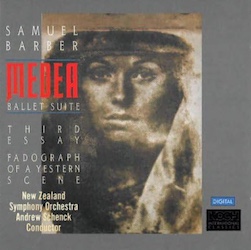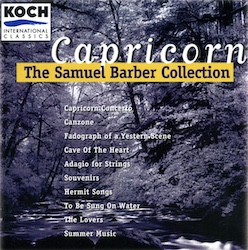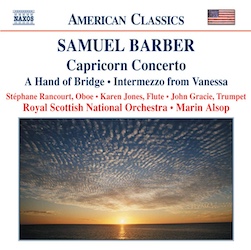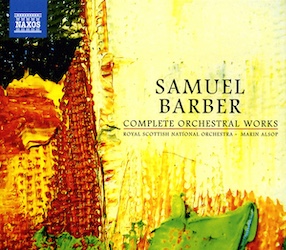Joyce Music – Barber: Fadograph of a Yestern Scene
- At February 06, 2022
- By Great Quail
- In Joyce
 0
0
But, lo, as you would quaffoff his fraudstuff and sink teeth through that pyth of a flowerwhite bodey behold of him as behemoth for he is noewhemoe. Finiche! Only a fadograph of a yestern scene.
—James Joyce, “Finnegans Wake” 7.12-15
Fadograph of a Yestern Scene, op. 44
(1971)
For orchestra (approx. 7-9 minutes)
Among the first scenes a reader encounters in James Joyce’s Finnegans Wake is, unsurprisingly, an Irish wake. A boozy riot of mock-blasphemous gluttony and musical cacophony, one lovely phrase floats softly from the page at 7.15: “only a fadograph of a yestern scene.”
The early seventies were a profoundly unhappy time for Samuel Barber. His opera Antony and Cleopatra had flopped, his romantic relationship with Gian Carlo Menotti had ended, and he was forced to sell Capricorn, their beloved Mount Kisco home. Depressed and battling alcoholism, Barber was cheered by receiving a commission from the Pittsburgh Symphony Orchestra. As he had so many times before, he turned to James Joyce for inspiration, plucking a “punning line” from his memory: “a fadograph of a yestern scene.” According to Barber’s biographer Barbara Heyman, Barber was too consumed by sorrow and alcohol to remember whether this phrase came from Finnegans Wake or not, and wrote to his friend Charles Turner to confirm the source for the program notes.
It was a felicitous bit of recall on Barber’s part—Fadograph of a Yestern Scene could hardly have a better name. Opening with a soft cascade of harpstings and a gorgeous melody from the oboe, Fadograph develops slowly, its colors already muted by the wistful sepia of nostalgia and recollection: Debussy’s La Mer as seen from the other end of a century that’s witnessed the surge and retreat of Romantic tonality. Melodies emerge tentatively, drifting above an undulating bed of strings while woodwinds turn in slow spirals. Occasional spumes of brass adds flashes of color, while the celeste shimmers like distant starlight. Every so often the orchestra surges to a lush climax, but just before a sense of revelation can be established, the music recedes back into the twilight of memory. The end comes unexpectedly, a fading exposure into timeless silence.
Borrowing elements from his withdrawn-and-destroyed Second Symphony, Fadograph was a quiet piece of pure Romanticism, a melancholy sigh from a composer who felt the sun was setting on his life and times. Its poignant melodies are touched by a sense of longing, but Fadograph is a work of reflection, not regret: the sepia tones of nostalgia never darken into despair. In the end, Barber liked the title so much he used it for his childhood memoirs, twelve typed pages written in 1974 and never published.
Excerpt from Samuel Barber: The Composer and His Music
By Barbara Heyman
Samuel Barber: The Composer and His Music
Oxford University Press, 1992
Not long after he completed the score of The Lovers in May 1971, Barber told Manfred Ibel about another commission he had received… He was referring to Fadograph of a Yestern Scene, commissioned by the Alcoa Foundation for William Steinberg and the Pittsburgh Symphony Orchestra in honor of the opening of the new Heinz Hall… In August, liberated from the pressure of having completed two commissions within two months of each other, Barber was at ease and working his way through the sixth volume of Anthony Trollope’s Barsetshire series. He requested a favor from Turner:
The title of the Pittsburgh piece . . . is “Fadograph of a Yestern Scene”— from Joyce, natch, but which book?? It’s Finnegans I think. But can’t be sure as I have no books here. Ask Elizabeth [Hardwick Lowell]! And let me know soon, please, as they want to know the exact source for the program notes.
[Footnote: Letter, 3 August 1971, from Santa Cristina in Val Gardena, Italy. The fact that Barber had to ask Turner about the source of the Joyce text—of which the language is so distinctive and which in 1947 had provided him with a passage for his song Nuvoletta—seems to corroborate Dr. Jack Nelson’s report that Barber’s memory was at this time beginning to be seriously impaired from alcohol.]
It is not known whether the “punning line of James Joyce”—to use Barber’s words—from Finnegans Wake (p. 7, line 15) inspired Fadograph from the onset of its composition, or whether, when the piece was completed, he made the literary association because of the music’s affinity to his earlier style. The music is reflective in several aspects: Barber returns to Joyce, a poet whose work had inspired his music since the 1930s; the harmonic language and romantic themes of Fadograph bespeak the old Barber; and more specifically, there are musical allusions to a work he seemed never able to completely abandon—the Second Symphony.
If he was indeed remembering Joyce’s passage when he wrote this orchestral piece even without recalling which book it came from, it seems likely that his imagination would have been captured by the alliteration, onomatopoeia, and humor of the author’s punning references to musical instruments:
And all the way (a horn!) from fjord to fjell his baywinds’ oboboes shall wail him rockbound (hoahoahoah!) in swimswamswum and all the livvy-long night, the delldale dalppling night, the night of bluerybells, her flitta-flute in tricky trochees (O carina! O carina!) wake him. . . . Only a fadograph of a yestern scene.
Barber’s Fadograph of a Yestern Scene is a single-movement work, without key signature. The orchestral texture is transparent, yet the forces are large: piccolo, two flutes, two oboes, English horn, two clarinets, bass clarinet, two bassoons, four horns, three trumpets, three trombones, tuba, timpani, percussion, antique cymbal, celesta, two harps, piano, and strings. The many solos for woodwind and brass instruments never—as do Joyce’s— “wail,” but they have, rather, the fluidity and grace of Barber’s invention. The plucked arpeggios of harps and muted tremolos of strings intone a veiled and mysterious backdrop against which a lone oboe unfolds a diatonic primary theme in 7/4 meter; the melody is echoed by a muted horn. A bassoon melody is picked up in turn by a muted French horn, an English horn, a harp supported by pizzicato violas, and, finally, muted strings. Against the song fabric is a lyrical countertheme, its profile transfigured as the piece progresses. Concurrently, a motive from the principal theme of Barber’s discarded Second Symphony offers a counterpoint to the melodic lines, subtly at first, then increasingly persistent. The motive, which was ominous and plodding in the symphony and which was used again in Antony and Cleopatra for the militaristic entrance of Caesar and Antony into the Roman senate, now takes on an exotic cast in the context of the veiled harmonies of Fadograph.
Eerie orchestral color is promoted by special instrumental effects—divisi passages, tremolos placed in high registers, and bowings sul ponticello for stringed instruments; unusual pairings—piccolo and celesta, flute and horn; and specific performance instructions—“from the distance,” “echo,” “Snare drum on handkerchief, without snares,” and “punta d’arco.”
Fadograph of a Yestern Scene was conducted by Steinberg on 11 September 1971 during the inaugural concert of the $7-million Heinz Hall in Pittsburgh. It was not overlooked by music critics that the composer was as solidly entrenched as ever in his Romantic outlook: “a quiet impressionistic work that might have come from a musical era long since past,” wrote Allen Hughes in a review in the New York Times. “It is pretty music, skillfully wrought, and a century from now no one will be much concerned with the fact that it seemed an anachronism at its premiere.” Such comments may be better understood in the context of Frederick Dorian’s program notes, which compare Fadograph to other music played during the early 1970s:
The musical spell of Fadograph of a Yestern Scene reaches us through a romantically inspired score. The lines are easier traced than its more subtle, secret ties to Finnegans Wake. Barber’s music, both at its lyrical and more dramatic phases, is softly affectionate. The dynamics shun the large volume. Often, the music speaks only in a low voice. This is fortunate in a world that may prefer to listen to nothing but shouts.
Although Fadograph of a Yestern Scene was played again by the Pittsburgh Symphony Orchestra in New York in November 1971, and by the Cleveland Orchestra in June 1972, it is another of those late works of Barber’s that has rarely been heard since.
Liner Notes from Koch’s Samuel Barber: Medea
By Philip Kennicot
Samuel Barber: Medea
Koch, 1990
The Fadograph of a Yestern Scene, Op. 44 takes its title from a more contemporary examination of the subconscious, James Joyce’s Finnegans Wake. Barber turned to Joyce’s writings several times during his career; the songs from Op. 10 and his Nuvoletta, Op. 25 are both settings of Joyce texts. Other Bareber works, including the Hermit songs, reveal a general love of Irish poetry and literature.
Unlike its literary source, Barber’s Fadograph in neither opaque nor obscure. It is a short work, quiet and affectionate. An opening oboe line sets the mood, lyrical and reflective. In its single movement, the Fadograph never reaches more than a dignified climax and its passions are the gentle sort. The work is principally based on two themes, the opening ascending line, written in a calmly shifting 7/4 meter, and a second triplet theme announced shortly thereafter.
Liner Notes from Naxos’ Samuel Barber: Orchestra Works Vol. 6
By Daniel Felsenfeld
Samuel Barber: Orchestral Works Vol. 6
Naxos, 2004
In the years following Barber’s catastrophic opera Antony and Cleopatra, his second commission from the Metropolitan Opera, Barber was more of a reluctant composer. He sank into a depression, into an alcoholic despair, only rising sporadically to write a piece. One of these, Fadograph of a Yestern Scene, is a single-panelled orchestral work. The title comes from James Joyce’ s Finnegans Wake, one of Barber’ s favourite books, but the music comes more out of Debussy than any of his other works, slow, impressionistic washes of sound, large forces yet a spare texture. The Pittsburgh Symphony commissioned it, and it was the last orchestral work of any scope Barber wrote.
Text
Source: Finnegans Wake
FW 7.4-7.19
With her issavan essavans and her patterjackmartins about all
them inns and ouses. Tilling a teel of a tum, telling a toll of a tea-
ry turty Taubling. Grace before Glutton. For what we are, gifs
à gross if we are, about to believe. So pool the begg and pass the
kish for crawsake. Omen. So sigh us. Grampupus is fallen down
but grinny sprids the boord. Whase on the joint of a desh? Fin-
foefom the Fush. Whase be his baken head? A loaf of Singpan-
try’s Kennedy bread. And whase hitched to the hop in his tayle?
A glass of Danu U’Dunnell’s foamous olde Dobbelin ayle. But,
lo, as you would quaffoff his fraudstuff and sink teeth through
that pyth of a flowerwhite bodey behold of him as behemoth for
he is noewhemoe. Finiche! Only a fadograph of a yestern scene.
Almost rubicund Salmosalar, ancient fromout the ages of the Ag-
apemonides, he is smolten in our mist, woebecanned and packt
away. So that meal’s dead off for summan, schlook, schlice and
goodridhirring
Recordings
 |
 |
Barber: Fadograph of a Yestern Scene (1990)
Conductor: Andrew Schenck
Musicians: New Zealand Symphony Orchestra
CD: Medea Ballet Suite; Third Essay; Fadograph. Koch 3-7010-2 (1990)
CD: Capricorn: The Samuel Barber Collection. Koch 3-7361-2 (1996)
Purchase: CD [Amazon (1990) | Amazon (1996)], Digital [Amazon]
Online: YouTube
Andrew Schenk recorded Fadograph in October 1989 at Symphony House in Wellington, New Zealand. This was originally released on CD by Koch in 1990 with Barber’s powerful Medea as the main feature—one of my personal favorite pieces of Barber’s music. In 1996 Koch reissued Schenck’s Fadograph on a CD called Capricorn: The Samuel Barber Collection. Shorter that Alsop’s version by almost two minutes, Schenck’s faster tempo is balanced by a dreamier texture that suits the piece nicely.
 |
 |
Barber: Fadograph of a Yestern Scene (2004)
Conductor: Marin Alsop
Musicians: Royal Scottish National Orchestra
CD: Barber Orchestral Works Volume 6: Capricorn Concerto. Naxos 8.559135 (2004)
Box Set: Samuel Barber: Complete Orchestral Works. Naxos 8.506021 (2004)
Purchase Album: CD [Amazon], Digital [Presto Music]
Purchase Box Set: CD [Amazon], Digital [Presto Music]
Online: Naxos | YouTube
In 2004 Marin Alsop recorded Fadograph with the Royal Scottish National Orchestra as part of Naxos’ wonderful “American Classics” series. Lasting nearly two minutes longer than Andrew Schenck’s 1990 recording, Alsop gives the wistful piece more time to breathe. The production quality is also superior to the Koch disc, but sharper edges aren’t necessarily an advantage for a piece like Fadograph. Both versions have their merits, and neither will disappoint.
Samuel Barber: Other Joyce-Related Works
Samuel Barber Main Page
Return to the Brazen Head’s Samuel Barber profile.
Songs from Chamber Music (1935-1937)
These six songs are settings of poems from Chamber Music.
Nuvoletta (1947)
A playful song with lyrics adapted from Finnegans Wake.
“Solitary Hotel” (1969)
From Despite & Still, this song has lyrics adapted from Ulysses.
“Now have I fed and eaten up the rose” (1972)
This song is based on James Joyce’s translation of a German poem by Gottfried Keller. It’s about a man who is buried alive.
Author: Allen B. Ruch
Last Modified: 23 June 2024
Joyce Music Page: Bronze by Gold
Main Joyce Page: The Brazen Head
Contact: quail(at)shipwrecklibrary(dot)com

